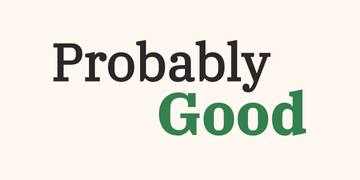A Fermi estimate—also known as a back-of-the-envelope calculation (BOTEC) or order-of-magnitude estimate—is a way to make rough but helpful estimates where precise data is unavailable. These can be used for anything – from estimating whether the world contains more wheels or doors, to how much positive impact a career might have.
In practice, a Fermi estimate involves breaking down seemingly complicated problems into small, manageable parts and then making reasonable assumptions about their values. By doing some simple math with these estimated values, we can arrive at an approximate answer that’s better than just guessing.
This technique is named after physicist Enrico Fermi, who was famous for his ability to make remarkably accurate approximate calculations with limited data. Famously, he was able to estimate the strength of an atomic bomb test based on how far pieces of paper traveled in the blast.
Example calculation
Let’s put a Fermi estimate into action.
Imagine Sofia, a doctor who has been practicing medicine for a few years. Looking to have more impact with her career, she’s interested in a job running a clinic in rural Ghana, where she’d help provide medical care to people who couldn’t otherwise easily access it.
To understand the difference she could make, Sofia wants to estimate how many lives she might save by taking the job. Instead of guessing outright, she breaks the problem into manageable parts. By structuring her estimate step by step, she arrives at a figure that’s far more insightful than a simple hunch.
Let’s run through how she might work this out.
Step 1: Determining the population served
First, Sofia wants to know how many people her clinic will serve. She asks about this during the interview process and learns that the clinic will serve around 2,000 people from nearby villages.
Step 2: Understanding common causes of death
Secondly, Sofia wants to know how many of these people might be expected to die each year–this will give her an upper bound for how many people she can help in the clinic.
Researching Ghana’s leading causes of premature death, she finds that strokes, tuberculosis, respiratory infections, and heart disease collectively account for 240 deaths per 100,000 people per year. For her clinic’s population of 2,000, that translates to about 5 deaths per year from these conditions.
Step 3: Estimating the difference her clinic could make
Finally, Sofia wants to estimate how treatable these causes of death are, so she can estimate how much difference the clinic will make.
Based on her previous medical knowledge and some quick research, Sofia estimates that 40% of these deaths could be prevented with adequate healthcare provided by the clinic. That means that running the clinic could save 2 lives each year, at least according to this rough Fermi estimate.
Obviously, there’s much more Sofia could do to make this a more robust estimate. For instance, she could consider the other improvements the clinic would make to people’s lives beyond just preventing deaths.
She could also consider the counterfactual—if she doesn’t take the job, would someone else equally qualified step in? Answering this would give her a better sense of how much additional impact she personally brings to the role.
The key takeaway? Breaking a complex question into smaller, approachable pieces allows us to make useful estimates—even with limited data. And if needed, we can incorporate more variables and better research to refine our understanding further.
Using Fermi estimates
You can use Fermi estimates yourself in various important decisions, like when trying to figure out which cause to focus your efforts on, evaluating different organizations you might want to join, or deciding whether to accept a job offer.
To get the most out of Fermi estimates, the first thing to do is to figure out exactly what it is you want to estimate. Then, you need to identify the key components that will contribute to your overall estimate. Think of this as breaking down a complex problem into smaller, more manageable pieces.
After that, you’ll need to estimate each of those components. Be clear about any assumptions that you’re making, so you can evaluate and potentially change them later.
For example, suppose you’re estimating how many doors exist in the world. You might begin by assuming an average number of doors per house, and guessing how many houses there are to get an initial number.
To strengthen your estimate, experiment with different inputs. Try adjusting an assumption, consider both pessimistic and optimistic scenarios, and use upper and lower bounds to gauge a range of possible answers.
Additionally, it’s good practice to sanity-check your results. If your estimate suggests you would help 40,000 people in a specific region, but only 20,000 people actually live there, something in your assumptions is off.
Fermi estimates are inherently rough approximations—not precise answers. Their value lies in providing a good-enough calculation that quickly gives insight into an important question. Often, this is all we need. A simple back-of-the-envelope estimate might show that one career path or decision is clearly better than another, without requiring exact numbers.
On the one hand, this means that you should be okay with their imprecision and not worry too much about trying to use them to get an exact result. They’re a useful tool for getting in the ballpark of a correct answer, but not for getting it exactly right. Often, this is all we need–a quick back-of-the-envelope calculation might show us that one option is much better than the other.
At the same time, it’s important to recognize their limitations. While they are useful for narrowing down choices and identifying promising directions, they shouldn’t be relied upon more than is appropriate.
Despite these limitations, Fermi estimates can be helpful for important decisions such as planning a high-impact career. Making rough estimates of how impactful a job might be, how good we might be at something, or how important a global problem is can steer us in the right direction for what we should do – even if they don’t give us perfect answers.
- Quantified Intuitions runs a monthly estimation game where you can try making Fermi estimates on a bunch of topics.
- Zach Robinson’s talk on using back-of-the-envelope calculations to prioritize interventions.
- Ian Ray on whether there are more wheels or doors – a great example of a Fermi estimate in action.

